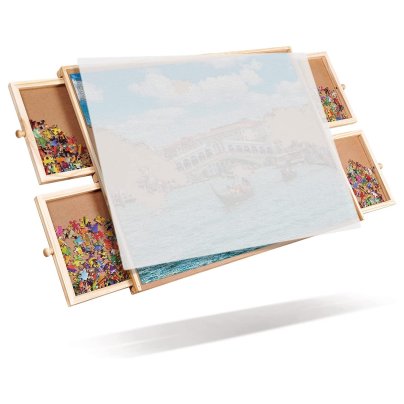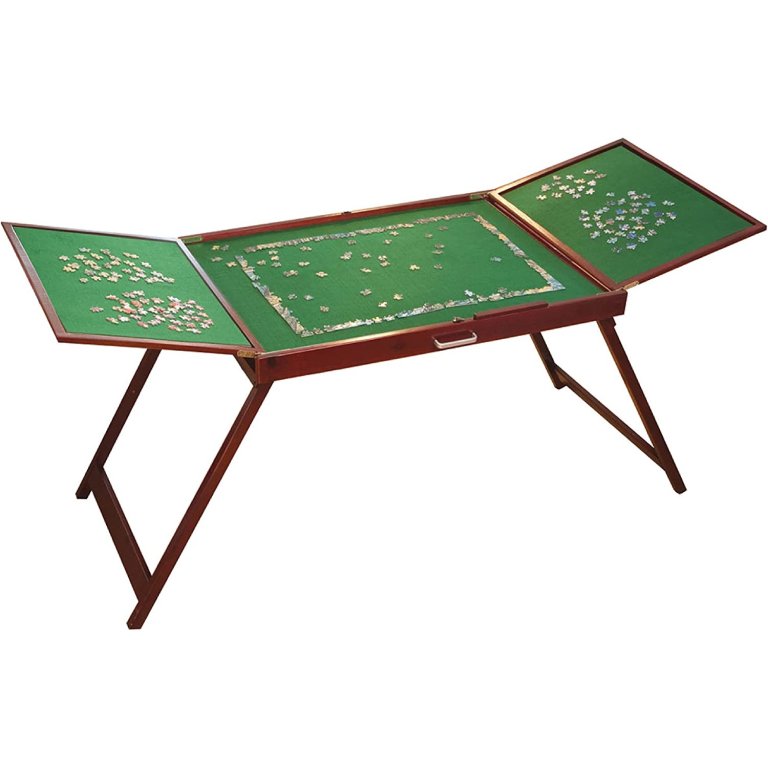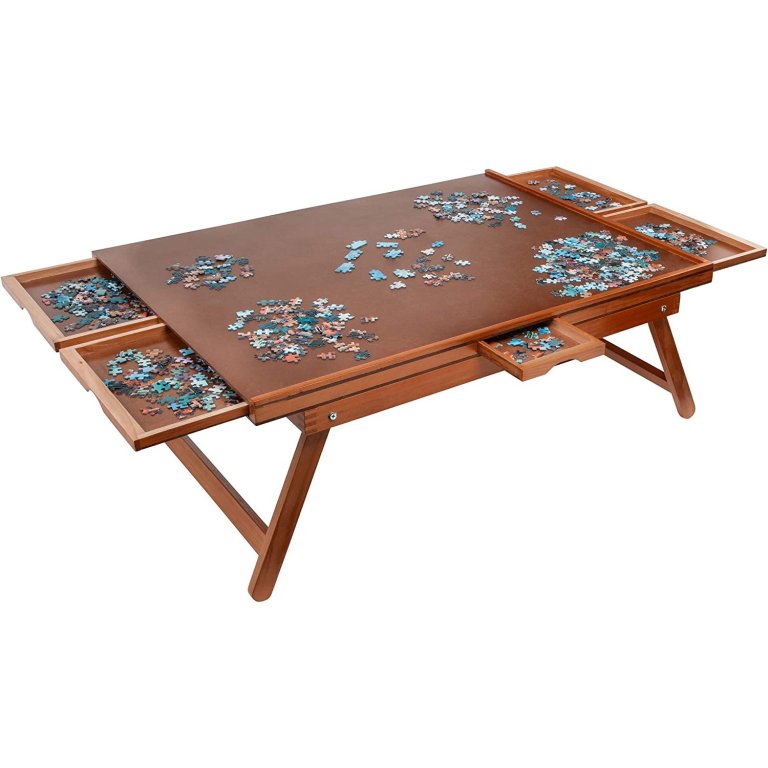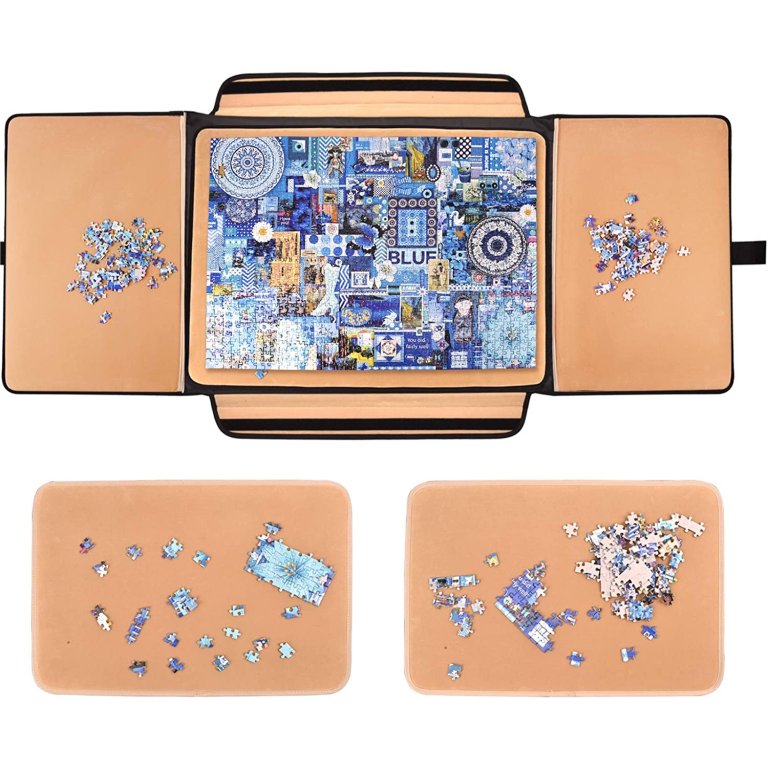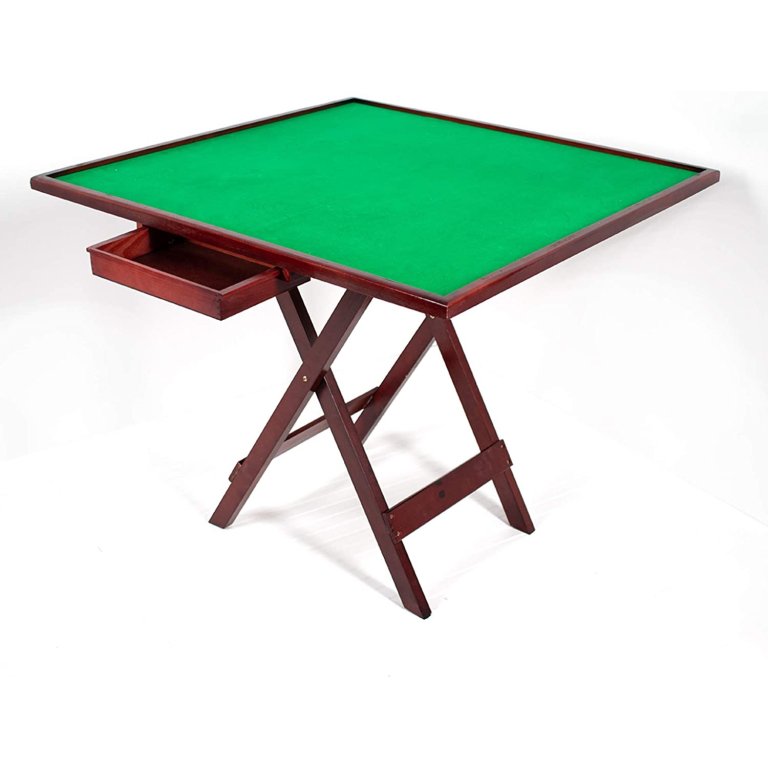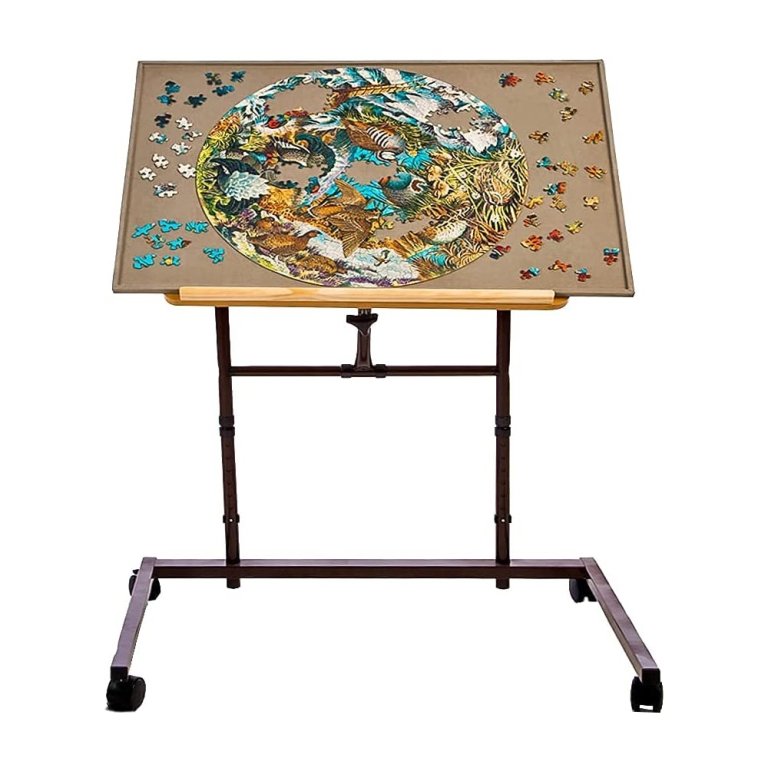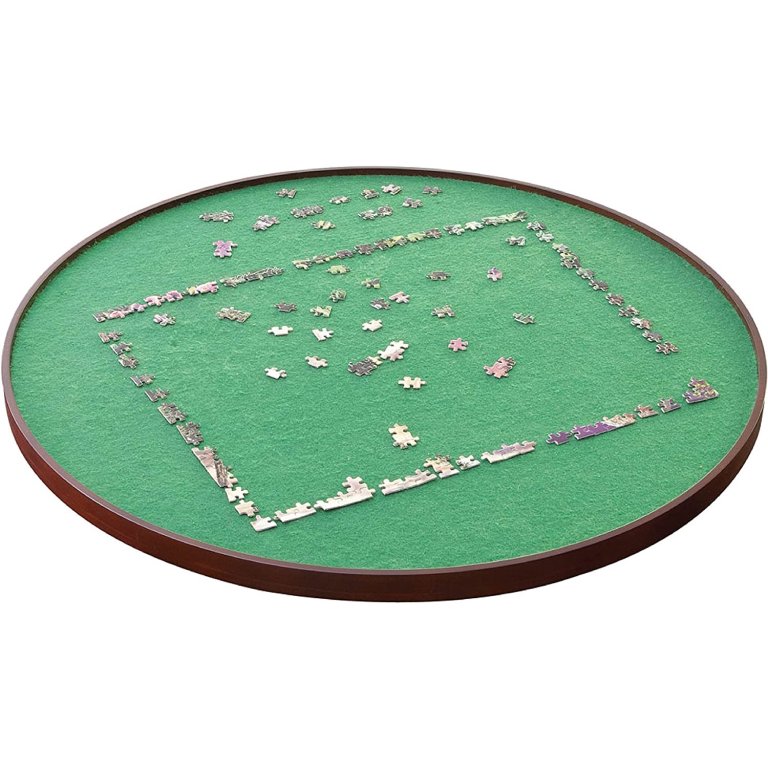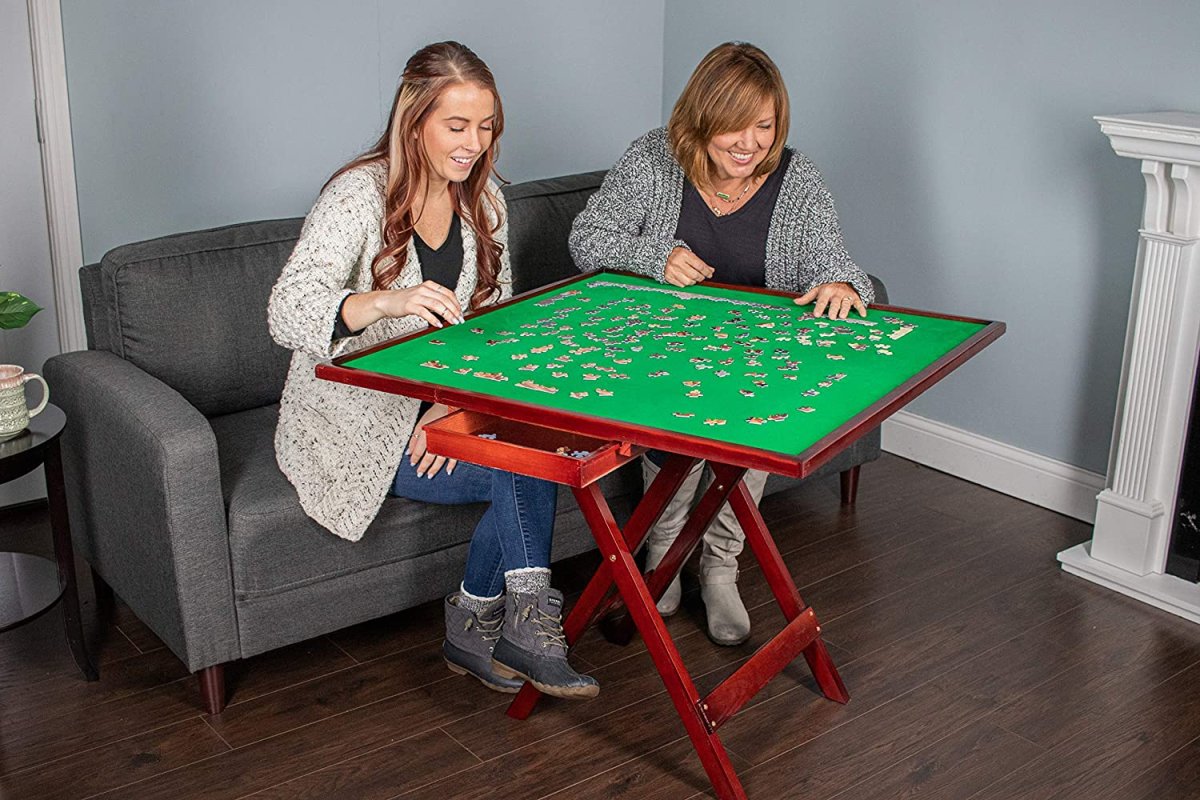
We may earn revenue from the products available on this page and participate in affiliate programs. Learn More ›
Jigsaw puzzles have experienced a surge in popularity since the start of the COVID-19 pandemic, and their appeal doesn’t seem to be waning. Completing a puzzle without a dedicated puzzle table, however, can cause clutter in your living space, especially for those with smaller homes.
Buying a puzzle table online can feel a bit overwhelming because so many options are available at a wide range of prices. This article breaks down types and features to look for when shopping for the best puzzle tables and discusses the key considerations to keep in mind while evaluating products. Use this guide for tips on choosing the ideal option, and explore our curated picks for some of the best tables for puzzles.
- BEST OVERALL: Bits and Pieces Fold-and-Go Wooden Jigsaw Table
- BEST BANG FOR THE BUCK: Becko Wooden Jigsaw Puzzle Board
- BEST BOARD: Gamenote Wooden Jigsaw Puzzle Table
- BEST WITH DRAWERS: Jumbl Freestanding Wooden Puzzle Board
- BEST PORTABLE: Rekcopu 1500 Pieces Jigsaw Puzzle Board
- BEST FOLDING: Mary Maxim Puzzle Table
- BEST ADJUSTABLE: Jigthings Jigtable
- BEST ROTATING: Bits and Pieces Round Puzzle Spinner Surface
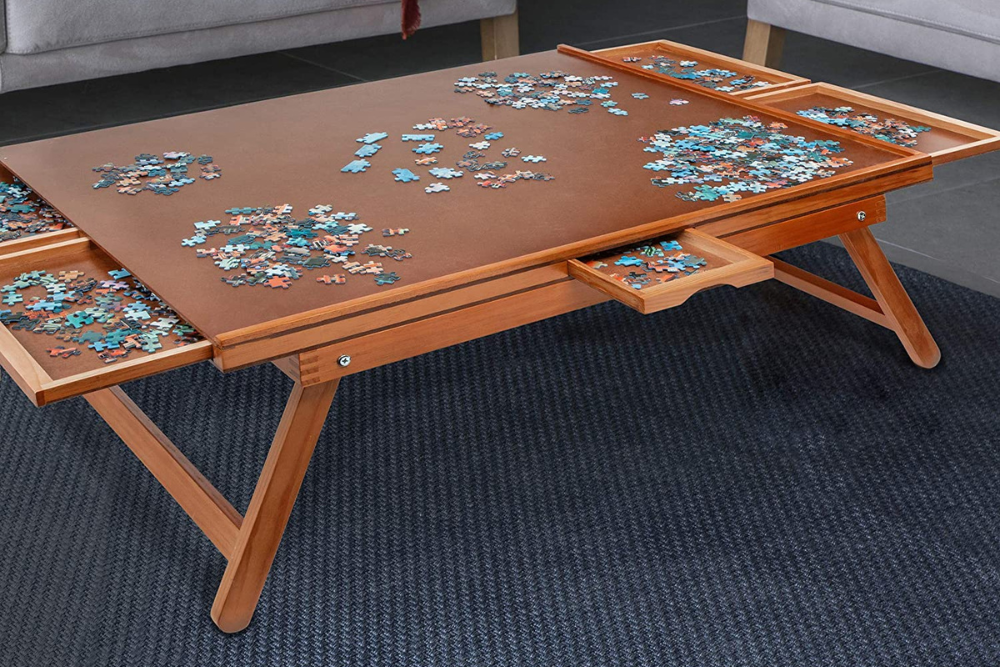
What to Consider When Choosing the Best Puzzle Table
Although it’s easy to assume that all puzzle tables offer similar performance, several factors affect their functionality. Some important features to keep in mind when considering the best puzzle tables include the following.
Table vs. Board
While the term “puzzle table” is used broadly to describe flat surfaces used for assembling jigsaw puzzles, there are two subtypes.
- Puzzle boards are designed to be placed directly on top of an existing table. They do not have legs and are therefore only elevated by a couple of inches.
- Puzzle tables have a similar design but have legs that elevate them, allowing them to be comfortably placed on a bed or coffee table or even used as freestanding furniture pieces. The legs typically fold down, allowing puzzle tables to also be used as puzzle boards.
Both puzzle boards and puzzle tables come in a variety of different styles to suit different needs.
Size
While puzzle tables come in a range of sizes, most are designed to fit a 1,000-piece jigsaw puzzle with room to spare. Their surface areas typically measure approximately 20 to 25 inches tall by 30 to 35 inches wide. A larger table may be necessary for larger 1,500- or 2,000-piece puzzles.
Most freestanding puzzle tables either have removable legs or fold down for compact storage since they’re not meant to be permanent fixtures. Folding puzzle tables offer an even more compact option, making them ideal for camping and travel.
Materials
Before choosing a puzzle table, consider the materials it’s made from. The material of both the frame and the puzzling surface are important when it comes to the table’s functionality and portability. Many puzzle tables feature wood frames. Made from either solid wood or engineered wood, these frames are sturdy and durable. Frames may also be made from metal, though metal frames are less popular and aren’t as readily available. Puzzle tabletops can have either a standard or nonslip surface. A felt tabletop prevents puzzle pieces from sliding around and is particularly advantageous on an angled puzzle table. Many manufacturers create nonslip tabletops using felt alternatives that serve the same purpose.
Shoppers should choose a puzzle table made from lightweight materials if they intend to use it while traveling or bring it from room to room within their home.
Additional Features
While all puzzle tables serve the same basic purpose, some offer useful additional features.
- A cover can be used to protect the puzzle while it’s not in use to ensure no pieces go missing.
- Drawers allow users to organize puzzle pieces and keep them tucked away before they are placed.
- Edges keep the pieces contained within a set space.
- Adjustable puzzle tables are designed like easels and can be adapted to be as comfortable as possible for the user.
- A lazy-Susan design allows the puzzle to rotate so the user can remain seated in the same position while puzzling.
Our Top Picks
With all that we’ve just learned about puzzle tables, it’s time to start shopping. The following are the top picks for the best puzzle tables for your home.
Best Overall
Bits and Pieces Fold-and-Go Wooden Jigsaw Table
Pros
- Available in 3 sizes
- Features a nonslip felt surface
- Folds up for easy storage
- Side panels can be angled for optimal comfort
Cons
- High price
Product Specs
- Type: Table
- Materials: Wood, metal, felt
- Surface dimensions: 34 inches long by 25 inches wide
The Bits and Pieces Fold-and-Go Wooden Jigsaw Table is a stand-alone puzzle table that comes in three sizes. It features a felt surface and adjustable side panels that can be angled up for a more comfortable setup. The felt tabletop ensures the pieces stay in place, no matter the angle. The frame is made from pine with a rosewood-stained finish.
One of the most useful features of this model is that it folds up to be very compact—measuring just 37.75 inches long by 26.5 inches wide by 2.5 inches deep—so it can easily be stored when it’s not in use. A metal handle makes it even more portable.
Get the Bits and Pieces Fold-and-Go puzzle table on Amazon.
Best Bang for the Buck
Becko Wooden Jigsaw Puzzle Board
Pros
- Affordable price
- Features a nonslip surface
- Folds up for easy storage
Cons
- Not suitable for large puzzles
Product Specs
- Type: Board
- Materials: Wood and flannelette
- Surface dimensions: 30.7 inches long by 22.83 inches wide
With a simple yet effective design, this puzzle board from Becko features a surface that can be angled for optimal ease of use. The board’s surface is covered with flannelette, which acts as an alternative to felt, and the base and frame are constructed from medium-density fiberboard (MDF).
Its 30.7-inch-long by 22.83-inch-wide usable surface area is perfect for 1,000-piece puzzles, but it won’t be able to accommodate larger puzzles. The bracket can be folded down to make the board easy to store or removed to be used with a different puzzle board.
Get the Becko puzzle table on Amazon.
Best Board
Gamenote Wooden Jigsaw Puzzle Table
Pros
- Includes drawers for puzzle-piece storage
- Made from wood
- Includes a translucent cover
Cons
- Can’t be angled
Product Specs
- Type: Board
- Materials: Wood
- Surface dimensions: 30 inches long by 22 inches wide
Puzzle enthusiasts know that keeping track of the hundreds of little pieces is no easy task. Fortunately, this puzzle board from Gamenote has some handy extras designed to keep pieces from going missing. Four shallow pull-out drawers provide plenty of space to organize the puzzle’s pieces by color or shape, while a translucent cover can be placed on top of the puzzle in between sessions to ensure no pieces go missing.
This board has a smooth surface that allows the pieces to slide easily, which some users find preferable to a nonslip felt surface. Integrated edges ensure the pieces remain on the board. With a working surface area of 30 inches long by 22 inches wide, this board is suitable for 1,000-piece puzzles but won’t work for larger puzzles.
Get the Gamenote puzzle table on Amazon
.
Best With Drawers
Jumbl Freestanding Wooden Puzzle Board
Pros
- Includes 4 drawers with magnetic closures
- Legs fold for easy storage
- Suitable for 1,500-piece puzzles
Cons
- Expensive
Product Specs
- Type: Table
- Materials: Wood
- Surface dimensions: 35 inches long by 27 inches wide
A puzzle table with drawers comes in handy for categorizing a puzzle’s pieces by color or shape. Not only does this puzzle table from Jumbl feature drawers for organizing, but the drawers feature magnetic closures to ensure they remain closed when the table is not in use. Stabilized legs, which are 13 inches long and fold up neatly for easy storage, allow the table to sit comfortably on top of either hard or soft surfaces, providing plenty of versatility.
The surface area is relatively large, measuring 35 inches long by 27 inches wide, making this table suitable for puzzles with up to 1,500 pieces.
Get the Jumbl puzzle table on Amazon or Wayfair.
Best Portable
Rekcopu 1500 Pieces Jigsaw Puzzle Board
Pros
- Available in 2 sizes
- Features a nonslip surface
- Folds up for easy storage
Cons
- Less aesthetically pleasing than other models
Product Specs
- Type: Board
- Materials: Fabric
- Surface dimensions: 35.4 inches long by 25 inches wide
Most puzzle tables and boards are relatively heavy, making them difficult to transport when camping or visiting friends or family, but at just 9 pounds, this portable board is designed to be lightweight and folds up to a compact size. It comes with a carrying case that’s waterproof, making this model a good choice for camping. The central panel can be removed and used alone or paired with the two side panels for an even larger work surface.
It’s available in two sizes, and the larger size measures 35.4 inches long by 25 inches wide, making it big enough for a 1,500-piece puzzle.
Get the Rekcopu puzzle table on Amazon.
Best Folding
Mary Maxim Puzzle Table
Pros
- Freestanding design
- Features a nonslip felt surface
- Folds up for easy storage
Cons
- High price
Product Specs
- Type: Table
- Materials: Wood, felt
- Surface dimensions: 35 inches long by 35 inches wide
Puzzlers without a lot of square footage in their living space would do well to consider this foldable puzzle table from Mary Maxim. In addition to featuring foldable legs that allow the table to be stored or transported with ease, this freestanding table can also be used for more than just puzzling. With a surface area of 35 inches long by 35 inches wide, it’s large enough to double as a small card table or gaming surface. Rounding it all out is the wood frame, which makes the table sturdy and stable.
Drawers set under the puzzling surface provide room for organizing puzzle pieces, and a felt-covered surface ensures puzzle pieces stay in place.
Get the Mary Maxim puzzle table on Amazon.
Best Adjustable
Jigthings Jigtable
Pros
- Freestanding table
- Fits a variety of different puzzle-board sizes
- Set on rolling casters
Cons
- High price
- Board must be purchased separately
Product Specs
- Type: Table
- Materials: Wood, aluminum
- Surface dimensions: Varies
When puzzlers have to crane their necks over a flat surface for a long period of time, puzzling can go from relaxing to a big pain in the neck. The Jigthings Jigtable addresses this issue by offering a puzzle table that can be angled to facilitate a comfortable position. Set on casters, this puzzle table can be rolled around for easy mobility.
The primary downside to this table is that it doesn’t include a puzzle board, requiring the user to purchase one separately. On the positive side, however, it’s compatible with puzzle boards of all sizes, allowing users to purchase the size that best suits the puzzles they prefer.
Get the Jigthings puzzle table on Amazon.
Best Rotating
Bits and Pieces Round Puzzle Spinner Surface
Pros
- Rotates using a lazy Susan
- Smooth rotation system
- Features a nonslip fabric surface
Cons
- High price
Product Specs
- Type: Board
- Materials: Wood, fabric
- Surface dimensions: 34-inch diameter
Putting together a puzzle typically requires moving around the table or board to observe one’s work from different angles. With this rotating model from Bits and Pieces, however, users can stay in place while using the lazy Susan to rotate the board in order to see and access every piece easily. The spinning system uses ball bearings, which make the movement smooth. With a 34-inch diameter, this round board is suitable for 1,000-piece puzzles.
The surface is covered in fabric, which helps the pieces stay in place. This version is round, but a square version is also available.
Get the Bits and Pieces Round puzzle table on Amazon.
Or, DIY Your Own Puzzle Table
Rather than buying a commercially designed product, those with some woodworking experience can also make their own version with a few simple supplies. In fact, a basic puzzle board can be made with an appropriately sized piece of plywood. For a slightly more functional version, consider adding edges to the board to keep the pieces in place. To turn the board into a puzzle table, simply add four legs. More advanced woodworkers can consider making a rotating puzzle board or even an adjustable, angled puzzle board.
Our Verdict
After reviewing this guide, buyers now know more about shopping for a puzzle table for their next jigsaw puzzle. We recommend the Bits and Pieces Fold-and-Go puzzle table for its versatile design and adjustability. Those on a budget might appreciate the Becko puzzle table, which offers great performance at a lower price point.
How We Chose the Best Puzzle Tables
Years of experience covering home and hobby supplies as well as extensive product research went into creating this guide. We explored more than 25 puzzle-table options and weighed several practical considerations before making our recommendations.
- Type: In an effort to provide a suitable range of options for different shoppers, we aimed to include puzzle tables of varying types in this guide.
- Reviews: We relied on reviews to ensure that the products we recommend receive positive feedback from users.
- Value: Puzzle tables range in price depending on their size, type, and the materials from which they’re constructed. We ensured that all the puzzle tables we recommend offer excellent value regardless of price.
FAQs
Though you now know more about puzzle tables, you may still have questions about choosing and installing them. Here are answers to some of the most frequently asked questions about puzzle tables.
Q. Are puzzle tables better than puzzle boards?
Puzzle tables and puzzle boards both offer unique advantages. Puzzle boards are ideal for use on top of an existing table, whereas puzzle tables are a great choice for those who have room for a freestanding piece of furniture.
Q. What should I look for in a puzzle table?
Look for a puzzle table or board that is the right size for the puzzles you use and has additional features that suit your needs.
Q. Can I make my own puzzle table at home?
Yes, amateur woodworkers can easily make a puzzle table at home by following the instructions listed above.
Q. How does a puzzle table work?
A puzzle table provides a dedicated surface for completing jigsaw puzzles that can be easily moved when it’s not in use.


